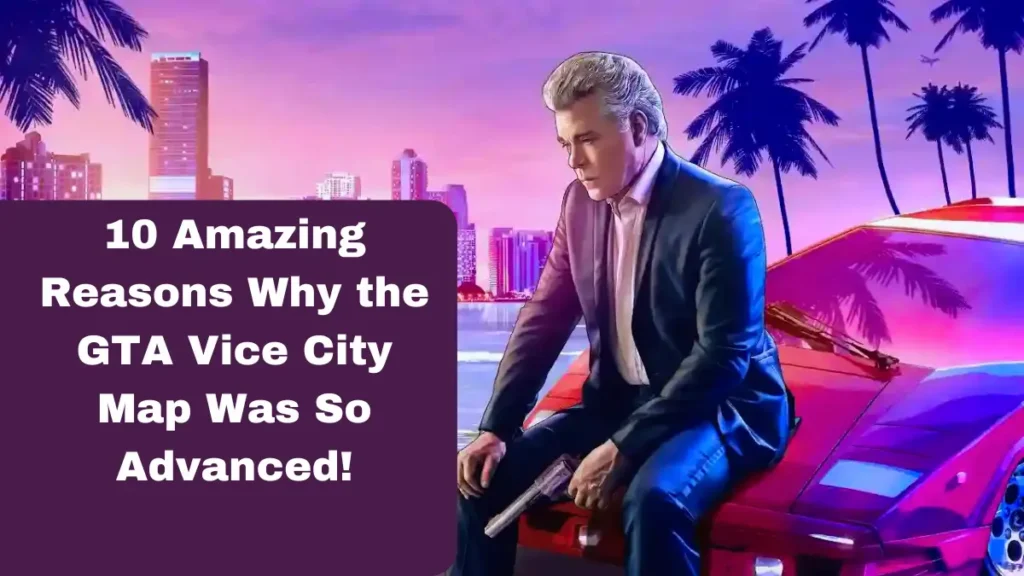Good morning, folks! Today, we’re taking a nostalgic trip back to the year 2002. That was the year when Rockstar Games released a game that would change the world of open-world gaming forever – Grand Theft Auto: Vice City. Here are ten amazing reasons why the map of Vice City was far ahead of its time. Only when you consider these key aspects will you realize just how transformative this game really is.
GTA Vice City: Key Information
| Category | Key Information |
|---|---|
| Launch Date | October 29, 2002 (PS2), May 13, 2003 (PC), October 31, 2003 (Xbox) |
| Official Site | www.rockstargames.com/vicecity |
| Platforms | PlayStation 2, PC, Xbox, iOS, Android |
| Developer | Rockstar North |
| Publisher | Rockstar Games |
| Genre | Open-world, Action-adventure |
| Benefits | – Immersive open-world experience – Engaging storyline – Improved gameplay mechanics – Memorable characters and soundtrack |
| Tips | – Explore the city to find hidden secrets and Easter eggs – Use the game’s radio stations to get hints and tips – Master the game’s driving mechanics to navigate the city efficiently |
| System Requirements (PC) | – Windows 98/ME/2000/XP – 800 MHz processor – 128 MB RAM – 8.5 GB free disk space – DirectX 9.0 compatible graphics card |
| Awards | – Game of the Year (2002) – BAFTA Interactive Awards – Game of the Year (2002) – Golden Joystick Awards |
1. Innovative Use of Space
To begin with, one of the most impressive aspects of the Vice City map was its innovative use of space. The developers at Rockstar North designed the city to be compact yet packed with exciting locations, hidden gems, and Easter eggs. What made roaming the city so exhilarating was the way it packaged thrills into tight, cozy spaces. The developers of Vice City seemingly agonized over every inch of their digital metropolis, imbuing it with a beguiling energy that beckons players to explore.
2. Attention to Detail
Next, the attention to detail in Vice City was simply unparalleled. From the neon-lit streets of Downtown Vice City to the sun-kissed beaches of Vice Point, every inch of the map was meticulously crafted. You must know that this level of detail transported players to the vibrant, crime-ridden world of 1980s Miami. By studiedly recreating the look and feel of different architectural styles, hand-picking evocative color palettes, and populated the streets with period-specific cars, the developers crafted a gaming environment that’s astonishingly lifelike.
3. Authenticity and Realism
Furthermore, the map of Vice City was heavily inspired by real-life Miami, with many landmarks and locations recreated to ensure an unparalleled sense of authenticity. You must appreciate the effort Rockstar North put into making the game world feel real. Authenticity was their north star, so they devoted themselves to learning Miami’s topography, ethos, and storied past to replicate it digitally. From pastel-colored Cadillacs to Walkmans and cassette tapes, every detail in this game screams 1980s Miami – an immersive treat for anyone looking to escape into a bygone era.
4. Non-Linear Gameplay
Moreover, Vice City’s open-world design allowed players to explore and complete missions in any order they chose. This was revolutionary at the time. Players were suddenly free to chart their own courses, untethered from the usual restrictions of a by-the-numbers gameplay experience. As they explored, the game world patiently waited, allowing each player to savor every moment without rushing them along. By shattering conventions and setting a new standard, Vice City’s groundbreaking design squarely ponerated the roadmap for future open-world games, its effect palpable to this day.
5. Immersive Atmosphere
In addition, the Vice City map was designed to be an immersive, living, breathing entity. You must know that the developers included a day-night cycle, dynamic weather, and an eclectic soundtrack that perfectly captured the essence of the 1980s. From corner to corner, the game world pulsed with energy, surprising me with its capacity to change and surprise at every turn. Whether it was a sunny afternoon or a rainy night, the atmosphere in Vice City was always captivating, drawing players deeper into the game.
6. Imagine switching between scenarios at will – from harsh climates to bustling cities.
Consider Vice City: an explosion of vibrant destinations, packed with local flavor and attitude that absolutely exploded off the screen. The game’s contrasts are staggering – Malibu Club shines bright, while Little Haiti whispers secrets in the shadows – and it’s up to you to explore both to really understand what makes this world tick. Pitting players against high-octane speed and adrenaline-fueled combat, the diverse environments are engineered to keep things fresh, never stagnating and always surprising.
7. Hidden Secrets and Easter Eggs
Furthermore, the developers at Rockstar North were notorious for hiding secrets and Easter eggs throughout the map. Dig in and get your hands dirty: every hidden crevice and concealed cranny holds the promise of a surprise. It wasn’t just about checking off boxes on a to-do list – players were fully immersed in the game, motivated by a desire to uncover the mysteries hidden within. Beyond the surface-level excitement, the game hiding hidden nuances, only revealed to those willing to dig deeper, offering an unsettling sense of uncertainty that replaced the comfort of a neatly labeled ‘mission accomplished’ checklist.
8. Seamless Navigation
Moreover, the Vice City map was designed to be easy to navigate. You must appreciate the clear roads, distinct landmarks, and intuitive layout that made it simple for players to find their way around. Unlike many other games of its time, getting lost in Vice City was a rare occurrence. Freed from getting lost, players could sink their teeth into the action and story, completely absorbed in the game.
9. Influence on Future Games
The innovative design and attention to detail in the Vice City map have influenced countless other open-world games. When this game hit the scene, it wiped the slate clean and redefined what we expect from an open-world experience. With this benchmark established, developers countrywide went all out to craft their own equally captivating game worlds. Vice City’s legacy can be seen in many of the popular open-world games we play today.
10. Time may fly, but certain things remain steadfastly cool. That’s what we mean by timeless appeal – an enduring wow factor.
In the annals of gaming, few virtual landscapes have captured our imagination like Vice City’s sprawling metropolis, where grit, crime, and extravagance thrive. Its style, smarts, and nostalgic vibe all come together to cast a spell that transcends age – from teenagers tofortysomethings, everyone gets swept up in the fun. You can’t deny the impact of Rockstar North’s efforts – the game’s staying power is a real achievement. With Vice City, the bar was raised for game designers everywhere, proving that diligence and creativity can lead to a gaming experience that lingers long after the credits roll.
Frequently Asked Questions (FAQ) about GTA Vice City Map
Q: What was the inspiration behind the design of Vice City’s map?
A: The map was inspired by Miami in the 1980s, with a focus on recreating the city’s art deco architecture, pastel-colored buildings, and vibrant beachside atmosphere.
Q: How big was the open world in Vice City?
A: The open world in Vice City was very big for its time. Imagine having the freedom to roam a gigantic area, complete with its own set of distinct neighborhoods. You could feel the differences between neighborhoods, like thumbprints on a city map.
Q: What game engine was used to create Vice City’s map?
A: The game used the RenderWare engine. What this engine accomplished was nothing short of remarkable: photorealistic 3D visuals, sumptuous lighting effects, and gameplay that glided along with effortless precision.
Q: What was innovative about the weather and time cycles in Vice City?
A: Weather that shifted like the real deal, and a clock that actually ticked away, made the game incredibly lifelike. Players could see the city in different weather, like sunny days and rainy nights.
Q: What made the game’s world in Vice City feel alive and realistic?
A: The game’s AI was advanced for its time, allowing non-playable characters (NPCs) to have their own routines, behaviors, and interactions. What emerged was a living, breathing world that wasn’t just backdrops and scenery – it was a tapestry of details that wrap around you.
Q: What made the game’s world in Vice City feel alive and immersive?
A: The game’s AI was advanced for its time, allowing non-playable characters (NPCs) to have their own routines, behaviors, and interactions. What emerged was a living, breathing world that wasn’t just backdrops and scenery – it was a tapestry of details that wrap around you.
| More Game News | https://apptn.in/tag/game-news |

